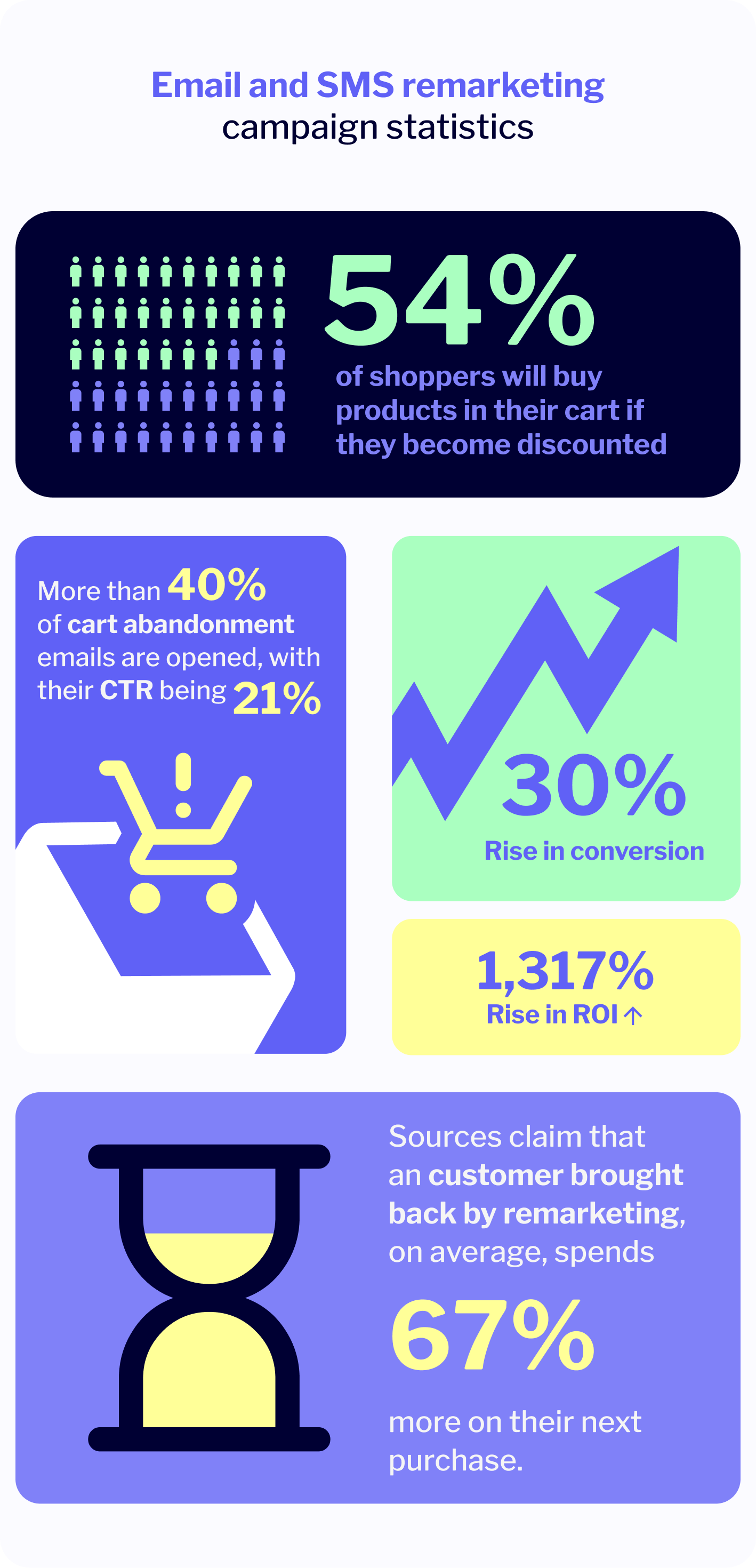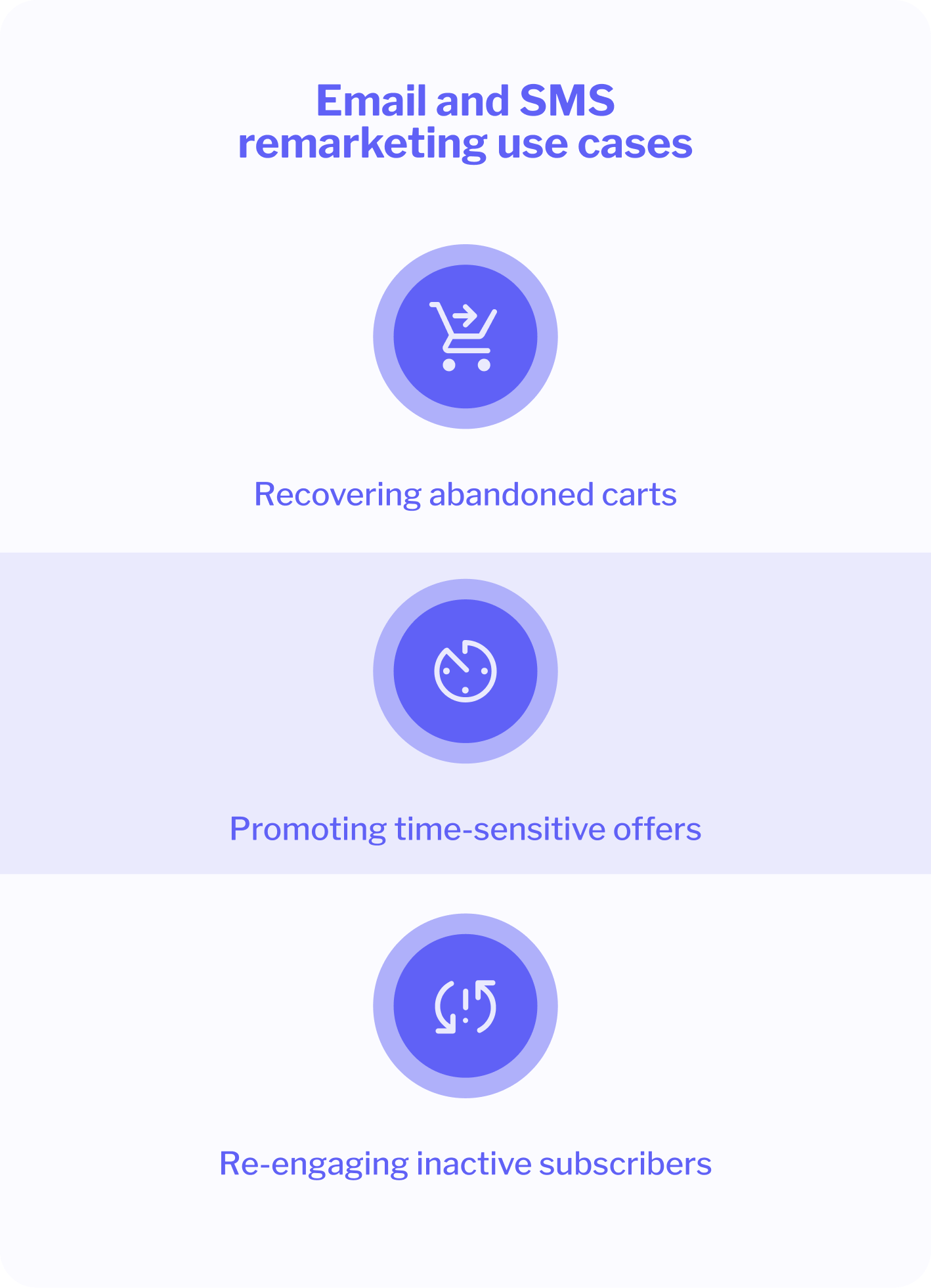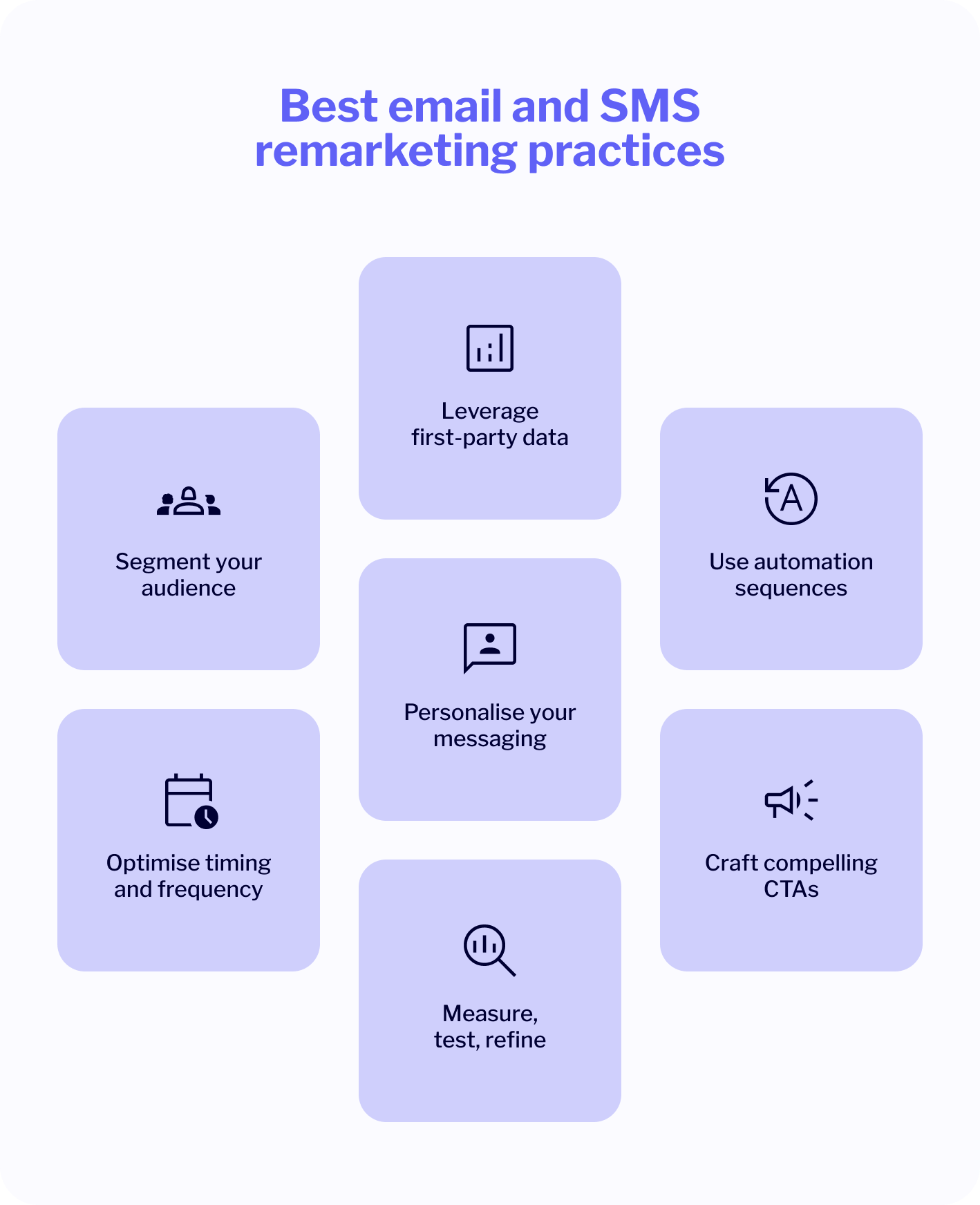Not every visitor who leaves an online store empty-handed is a lost opportunity. In fact, a missed conversion today could be tomorrow’s success. The secret behind it is persistence.
Luckily, it doesn’t take as much work as you might think. In many cases, particularly with online stores, the key to success lies in email and SMS remarketing. By reconnecting with potential customers via these channels, you can reignite their interest and drive them toward the conversion you’ve been hoping for.
In case you’re new to this kind of strategy, keep reading! In this article, you will discover how remarketing can help you stay top-of-mind, reclaim abandoned opportunities, and transform hesitation into action.
Retargeting vs. remarketing – Clearing the confusion
Before going into how to use SMS and email for remarketing, it’s important to understand the distinction between remarketing and retargeting. While the terms are often used interchangeably, they involve different approaches and channels.
- Retargeting usually relies on paid advertisements and cookies to re-engage website visitors across other platforms.
- Remarketing, on the other hand, typically makes use of a brand’s owned channels, such as email and SMS, to re-engage people who have already shared their contact information with you. They might’ve done it while making a purchase, after creating an account, or by signing up to a newsletter.
Below is a quick comparison to help clarify.
| Category | Remarketing | Retargeting |
|---|---|---|
| Definition | Re-engaging known contacts through owned channels using email and SMS. | Re-engaging users by placing advertisements on external websites or platforms. |
| Audience | Existing contacts in your CRM, including existing customers, leads, and newsletter subscribers. | Anonymous site visitors tracked via cookies or pixels. |
| Primary channels | Email, SMS, RCS | display ads, social media ads, search ads |
| Data sources | CRM data, subscriber lists, past purchase history | cookies, IP addresses, browser data |
| Typical tactics | Sending promotional emails or text reminders to known contacts. | Serving targeted ads on the Google Display Network, Facebook, etc. |
| Best suited for | Personalised follow-ups, direct communication. | Broad re-engagement of site visitors and lookalike audiences. |
With this distinction in mind, let’s focus on how remarketing using SMS and email can help you convert more prospects and strengthen customer loyalty.
What is SMS remarketing?
SMS remarketing is a marketing approach that uses text messaging to re-engage existing or potential customers who have already shared their phone number with your brand. These users may have demonstrated interest in your products by adding items to their cart or by signing up for your newsletter. At the same time, they haven’t yet converted into customers.
Unlike generic SMS campaigns, remarketing efforts rely on first-party data and aim to rekindle interest with targeted, relevant messages. SMS messages have an impressive open rate of up to 99 percent. For that reason, they serve as a powerful channel for quick, attention-grabbing campaigns.
When combined with other channels like email, SMS remarketing can prove to be incredibly helpful when it comes to nurturing leads and driving conversion rates.
How does SMS remarketing work?
SMS remarketing relies on first-party data and a structured communication process to deliver personalised messages. Generally, these steps come before launching your SMS remarketing campaign.
- Collecting and organising customer data Gather opted-in phone numbers through sign-up forms, checkout pages, or account registrations. Use your CRM or marketing automation platform to track each contact’s purchase history, past interactions, such as completed or incomplete orders, and any expressed interests. Unlike retargeting, which uses browser-based tracking, remarketing focuses on data your customers have shared willingly, such as their phone number, name, and purchase records.
- Identifying key trigger points Look for behaviours such as cart abandonment, lack of recent purchases, or sign-ups without subsequent engagement. When a user takes one of these actions, or fails to take the next step, your CRM flags them as a candidate for an SMS remarketing campaign.
- Sending targeted messages Craft concise, relevant SMS messages that address the reason why you’re reaching out. Here’s a good example. “We noticed you left items in your cart, here’s a special discount!” Timing is crucial. Send messages soon after the trigger event to keep momentum high.
What is email remarketing?
Email remarketing is a strategy that focuses on re-engaging people who are already on your mailing list, leveraging data from your CRM or marketing automation platform. By sending timely and relevant emails based on past interactions, such as browsing a product page but not purchasing, you nudge potential buyers back into the conversion funnel.
This differs from generic email blasts, as it is very behaviour-driven and highly personalised. For instance, if a subscriber has frequently opened past campaigns but never bought anything, you can send them a special incentive email to encourage that first purchase.
How does email remarketing work?
While each business’s remarketing process might vary, the following points are key to a well-structured email remarketing program.
- Building a qualified subscriber list Users enter your database after voluntarily signing up for newsletters, creating an account, or purchasing products. Because these individuals are already in your CRM, you have permission to send them emails. You also have in-depth access to their data, such as their purchase history and engagement levels.
- Segmenting based on behaviour and demographics Examine each subscriber’s interactions with your brand, such as past purchases, clicks on specific product categories, and email opens. Segment them accordingly. For instance, you could divide them into three groups – repeat purchasers, first-time browsers, and long-time no purchase. This makes sure your emails speak directly to their stage in the buyer’s journey.
- Sending targeted, triggered campaigns Automate messages triggered by certain behaviours, such as cart abandonment or being inactive for 30 days. Personalise subject lines, product recommendations, or incentives to reflect the recipient’s unique preferences or past activity.
Email and SMS remarketing campaign statistics
Numbers don’t lie, remarketing campaigns consistently drive results. Below are several compelling stats that highlight the power of SMS and email in boosting engagement and conversions among undecided users.
- More than 40 percent of cart abandonment emails are opened, with their CTR being 21 percent.
- 54 percent of shoppers will buy the products that are in their cart if these products are going to be available for a limited time. This is an excellent opportunity for conversion via email remarketing.
- Remarketing has shown incredible results, allowing some brands to drive a 30 percent increase in conversion and an impressive 1317 percent increase in ROI.
- Sources claim that a customer who’s brought back by remarketing, on average, spends 67 percent more on their next purchase.

3 ways to combine email with SMS remarketing in your marketing strategy
Customers’ attention is spread across various channels, with some people preferring email while others being more responsive to text messages. Each channel has unique strengths and suits different scenarios. By merging SMS and email, you can deliver a comprehensive and engaging experience.
Recovering abandoned carts
- Email: Send a detailed message showing the items a customer left in their cart, complete with images and descriptions.
- SMS: A few hours later, send a succinct text message offering a time-sensitive discount or free shipping.
Example
- Email: “Hey [Name], you left something behind! Check out your cart before it’s gone!”
- SMS: “Ready to complete your purchase? Use code ‘SAVE10’ for 10 percent off.”
Why it works:
Email provides the visual context, while SMS delivers a real-time nudge to act.
Promoting time-sensitive offers
- Email: Highlight special deals, upcoming sales, or product launches. Offer more details and interesting visuals.
- SMS: As the deadline nears, send a short message building urgency around the offer.
Example
- Email: “Flash Sale Alert: 20 percent off everything this weekend!”
- SMS: “Only 2 hours left to claim your 20 percent discount. Hurry!”
Why it works:
Email educates, while SMS incentivises immediate action.
Re-engaging inactive subscribers
- Email: Send a re-engagement campaign with personalised product recommendations or a special “come back” discount for inactive users.
- SMS: Prompt them with a concise reminder that their discount or special offer is about to expire, driving urgency.
Example
- Email: “We miss you! Here’s 15 percent off your next purchase to welcome you back.”
- SMS: “Time’s running out on your 15 percent discount. Don’t miss out, shop now!”
Why it works:
Email addresses potential barriers or highlights new offerings, while SMS ensures the message isn’t overlooked.

Best practices for building a successful remarketing campaign with email and SMS
When executed thoughtfully, combining email and SMS remarketing can yield impressive engagement and conversion results. Keep the following tips in mind to make your next remarketing campaign as effective as possible.
- Keep your CRM up-to-date
Make sure your CRM is well-maintained with up-to-date customer profiles. Remember to go through it on a regular basis. Doing it once a month or before major events, such as a major Black Friday sale, should be more than enough. - Segment your audience
Tailor messages based on user behaviour, such as past purchases and inactivity. This way, your content will feel relevant and timely. - Use automation sequences
Automate messages for specific triggers like cart abandonment or post-purchase cross-sells. This ensures timely outreach without manual effort. - Personalise your messaging
Insert first names and reference past purchases or browsing behaviour. Show that you understand each recipient’s needs. Even simple personalisation can boost open and conversion rates. - Optimise timing and frequency
Don’t bombard your subscribers. Instead, reach out to them when they’re most likely to engage, which is shortly after a trigger event or during times you know they’re active. - Craft compelling calls-to-action
Every remarketing message should point recipients to a clear call-to-action. You want the customer to know exactly what you want them to do. - Measure, test, refine
Track metrics like open rates, click-through rates, and conversions. Run A/B tests on subject lines, SMS copy, sending times, and offers to optimise continually.

Remarketing with email and SMS campaigns is more effective than you think!
Even with the rise of new digital communication channels, SMS and email remain cornerstones of a successful marketing strategy. Their unique strengths, SMS for quick, direct outreach and email for more in-depth communication, make them indispensable for engaging and converting both new and existing customers. By using SMS and email remarketing to re-engage your audience, you can build loyalty and deliver personalised experiences that drive real results. Take it from Michał Dmitrowicz, a Digital Marketing Manager at MessageFlow.
Remarketing via SMS and email is incredibly effective because it leverages an existing relationship. Your audience already knows your brand. This familiarity builds trust, making recipients far more likely to engage compared to cold outreach. When done right, these campaigns can work wonders: recovering abandoned carts, reducing churn, increasing return visits, and seamlessly guiding prospects further down the sales funnel. It’s like giving your leads a friendly nudge rather than a sales pitch from a stranger. And trust me, that nudge converts better!
Level up your SMS and email marketing with MessageFlow!
Now that you have a deeper understanding of these strategies, put them into action with MessageFlow! It’s a cross-channel communication platform that’s both effective and user-friendly.
With MessageFlow, you can reach customers at precisely the right stage in their customer journey, sending them relevant messages when they’re most receptive. Ultimately, this will lead to increased customer satisfaction and improve your bottom line.